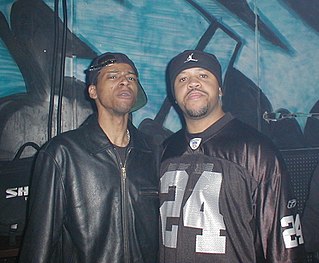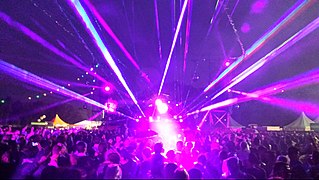Related Research Articles
House is a genre of electronic dance music characterized by a repetitive four-on-the-floor beat and a typical tempo of 120-130 beats per minute as a re-emergence of 1970s disco. It was created by DJs and music producers from Chicago's underground club culture and evolved slowly in the early/mid 1980s as DJs began altering disco songs to give them a more mechanical beat. By early 1988, House became mainstream and supplanted the typical 80s music beat.
Miami bass is a subgenre of hip hop music that became popular in the 1980s and 1990s. The use of drums from the Roland TR-808, sustained kick drum, heavy bass, raised dance tempos, and frequently sexually explicit lyrical content differentiate it from other hip hop subgenres. Music author Richie Unterberger has characterized Miami bass as using rhythms with a "stop-start flavor" and "hissy" cymbals with lyrics that "reflected the language of the streets, particularly Miami's historically black neighborhoods such as Liberty City, Goulds, and Overtown".
Chicago house refers to house music produced during the mid to late 1980s within Chicago. The term is generally used to refer to the original house music DJs and producers from the area, such as Ron Hardy and Phuture.

Ghettotech is a genre of electronic music originating from Detroit. It combines elements of Chicago's ghetto house with electro, Detroit techno, Miami bass.
Crunk is a subgenre of southern hip hop that emerged in the early 1990s and gained mainstream success during the early to mid 2000s. Crunk is often up-tempo and one of Southern hip hop's more nightclub-oriented subgenres. Distinguishing itself with other Southern hip hop subgenres, crunk is marked and characterized by its energetic accelerated musical tempo, club appeal, recurrent chants frequently executed in a call and response manner, multilayered synths, its pronounced reliance on resounding 808 basslines, and rudimentary musical arrangement. An archetypal crunk track frequently uses a dominant groove composed of a nuanced utilization of intricately multilayered keyboard synthesizers organized in a recurring pattern, seamlessly shifting from a lower to a higher pitch that encompasses the song's primary central rhythm, both in terms of its harmonic and melodic aspects. The main groove is then wrapped up with looped, stripped-down, and crisp 808 dance claps and manipulated snare rolls coupled and accompanied by a bassline of thumping 808 kick drums. The term "crunk" was also used throughout the 2000s as a blanket term to denote any style of Southern hip hop, a side effect of the genre's breakthrough to the mainstream. The word derives from its African-American Vernacular English past-participle form, "crunk", of the verb "to crank". It refers to being excited or high on drugs.
Deep house is a subgenre of house music that originated in the 1980s, initially fusing elements of Chicago house with the lush chords of 1980s jazz-funk and touches of soul music. Its origins are attributed to the early recordings of Larry Heard, including his influential track "Can You Feel It".
Electro is a genre of electronic music and early hip hop directly influenced by the use of the Roland TR-808 drum machines and funk. Records in the genre typically feature heavy electronic sounds, usually without vocals, although if vocals are present they are delivered in a deadpan manner, often through electronic distortion such as vocoding and talkboxing. It palpably deviates from its predecessor boogie by being less vocal-oriented and more focused on electronic beats produced by drum machines.

The Roland TR-909 Rhythm Composer, commonly known as the 909, is a drum machine introduced by Roland Corporation in 1983, succeeding the TR-808. It was the first Roland drum machine to use samples for some sounds, and the first with MIDI functionality, allowing it to synchronize with other devices. Though a commercial failure, it influenced the development of electronic dance music genres such as techno, house and acid house.
Tadao Kikumoto is Roland's senior managing director and head of its R&D center. He designed the TB-303 bass synthesizer and the TR-909 drum machine. He was also the chief engineer of the Roland TR-808 drum machine.

Liquid funk, liquid drum & bass, liquid DnB, melodic drum & bass, or sometimes just liquid is a subgenre of drum and bass. While it uses similar basslines and bar layouts to other styles, it contains fewer bar-oriented samples and more instrumental layers, harmonies, melodies and ambiance, producing a sentimental atmosphere directed at home listeners as well as nightclub and rave audiences. Music genres such as jazz, soul and sometimes blues have a pivotal influence on liquid funk.

Charles Chambers, better known by his stage name DJ Funk, is a Chicago house DJ who pioneered the ghetto house subgenre of house music. Through the 1990s, he built a regional reputation in the Chicago-Detroit region and in the Midwest rave scene. His 1999 album Booty House Anthems was distributed nationally and sold over one million copies. He founded the Funk Records label in 2006. He is included in Modulations, a 1998 film documentary of electronic music.
Techno is a genre of electronic dance music which is generally produced for use in a continuous DJ set, with tempos being in the range of 120 to 150 beats per minute (BPM). The central rhythm is typically in common time (4/4) and often characterized by a repetitive four on the floor beat. Artists may use electronic instruments such as drum machines, sequencers, and synthesizers, as well as digital audio workstations. Drum machines from the 1980s such as Roland's TR-808 and TR-909 are highly prized, and software emulations of such retro instruments are popular.
Footwork, also called juke, footwork/juke or Chicago juke, is a genre of electronic dance music derived from ghetto house with elements of hip hop, first appearing in Chicago in the late 1990s. The music style evolved from the earlier, rapid rhythms of ghetto house, a change pioneered by RP Boo. It may draw from the rapid rhythms and sub-bass frequencies of drum & bass. Tracks also frequently feature heavily syncopated samples from rap, pop and other sources, and are often around 160 bpm.

Rashad Harden, known as DJ Rashad, was a Chicago-based electronic musician, producer and DJ known as a pioneer in the footwork genre and founder of the Teklife crew. He released his debut studio album Double Cup on Hyperdub in 2013 to critical praise. He died in April 2014 from a drug overdose.

Work That Mutha Fucker is the debut EP by American house producer Steve Poindexter, released in 1989.
Bleep techno is a regional subgenre of techno which developed in the late 1980s in Northern England, specifically Yorkshire. Named after its minimalistic synthesizer sounds, bleep techno combined influence from American techno and house with electro elements and heavy sub-bass inspired by reggae sound system culture. The style was commercially successful between 1989 and 1991, and became associated with artists on the Sheffield label Warp Records. It has been characterized as the first uniquely British style of electronic dance music.
Teklife is an electronic music collective and record label from Chicago, Illinois. The group was founded by Rashad Harden and Morris Harper in 2011 in the city's suburbs, but rapidly gained traction among international audiences for pioneering the dance music genre footwork, a sped-up derivation Ghetto house which itself had been a local flavour of house music.

Deeon Boyd, known under his stage name DJ Deeon, was an American Chicago house DJ, credited with pioneering ghetto house and helping create the Dance Mania label.
References
- 1 2 3 4 5 6 McDonnell, John (3 November 2008). "Scene and heard: The ghetto house revival". The Guardian Music Blog. Retrieved 28 September 2013.
- ↑ Barat, Nick (26 January 2007). "Feature: On the Floor with Chicago's Juke DJs". Fader. The Fader, Inc. Retrieved 11 February 2013.
- ↑ Mueller, Gavin (2014). "Ghettotech and ghetto house". Grove Music Online. doi:10.1093/gmo/9781561592630.article.a2256635. ISBN 978-1-56159-263-0 . Retrieved 2021-05-05.
- ↑ "Interview: Parris Mitchell". Fact Magazine. 2016-01-08. Retrieved 2021-05-05.
- ↑ "Deep Inside: 'Hardcore Traxx: Dance Mania Records 1986-1997'". XLR8R. 2014-02-19. Retrieved 2021-05-05.
- 1 2 Matos, Michelangelo (3 May 2012). "How Chicago house got its groove back". Chicago Reader. Retrieved 28 September 2013.
- 1 2 Sheffield, Hazel (27 May 2010). "Footwork takes competitive dancing to the Chicago streets". The Guardian. Retrieved 11 February 2013.
- ↑ "The Five Most Bootylicious Ghetto House Tracks Ever, According to DJ Deeon". www.vice.com. Retrieved 2021-04-21.
- ↑ "The Essential... Dance Mania". Fact Magazine. 2013-08-13. Retrieved 2021-05-05.
- 1 2 Kerr, Stephen (16 August 2014). "A Love Letter to Chicago Juke". DANOEF. Retrieved 25 August 2015.
- ↑ Quam, Dave. "Bangs & Works Vol. 1 Liner Notes". Planet Mu. Archived from the original on 13 May 2012. Retrieved 14 May 2012.